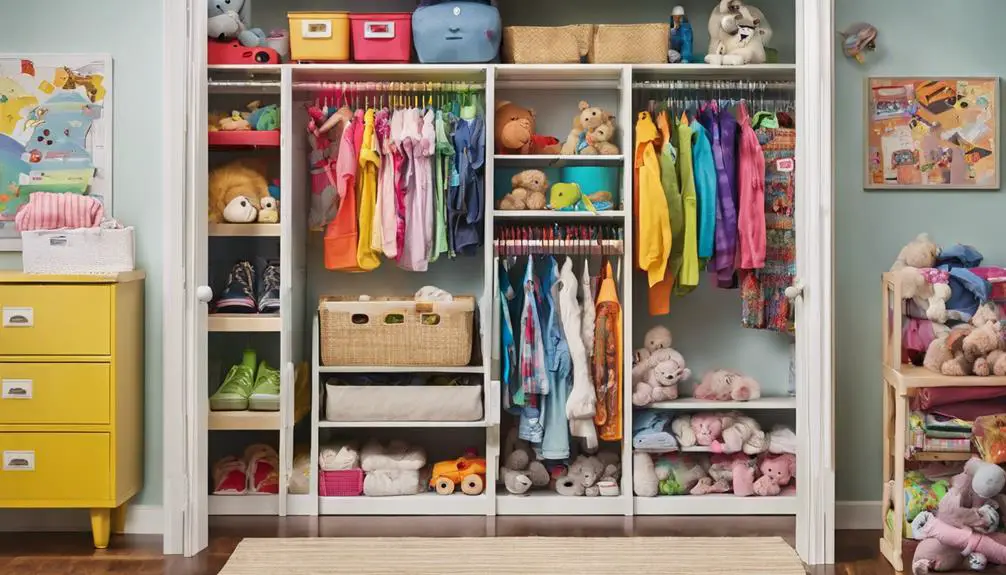You're tired of stepping into your kid's closet and being overwhelmed by the chaos. It's time to teach them the skills they need to take control of their space. By categorizing items into keep, donate, and discard piles, you can help your kid let go of items that no longer serve a purpose. But that's just the beginning. You'll need to create a system that makes sense to them, one that they can maintain on their own. The question is, where do you start, and how can you guarantee your kid will stick to it?
Sorting and Purging Their Belongings
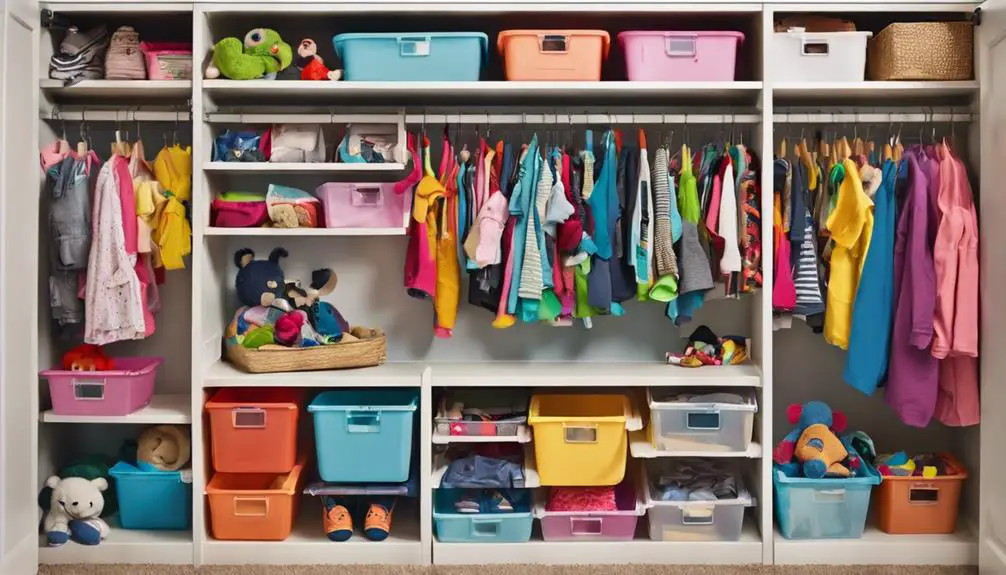
In the midst of your closet organization project, sorting and purging your belongings is a pivotal step that requires some tough decisions.
As a kid, it can be challenging to part with items that hold sentimental value or memories. However, it is vital to approach this task with a discerning eye, considering each item's usefulness, condition, and relevance to your current needs.
When sorting, categorize items into three piles: keep, donate/sell, and discard.
Be honest with yourself about each item's purpose and whether it sparks joy or serves a functional need. Ask yourself, "When was the last time I used this?" or "Do I still love this item?" If the answer is no, it's likely time to let it go.
Decision making is a vital aspect of this process.
Encourage yourself to think critically and make intentional choices about what you want to keep in your closet. Remember, the goal is to create a space that reflects your personality and meets your needs.
Assigning a Home for Each Item
You'll want to designate a spot for each item in your closet, so everything has a specific place to go.
This will help you keep similar items together and make the most of your space. By categorizing and grouping like items, you'll create a logical and functional system that makes sense for your lifestyle.
Designate a Spot
What's the secret to maintaining a clutter-free closet? It's simple: designate a spot for each item.
By assigning a home for everything, you'll encourage your kids to put things back where they belong, making it easier to find what they need and preventing clutter from building up.
Start by identifying the types of items your kids need to store, such as clothes, shoes, accessories, and toys.
Then, label areas within the closet for each category. You can use personalized signs or colorful stickers to make it fun and engaging. For instance, you can label a section for dresses, another for t-shirts, and another for jeans.
Within each section, designate a specific spot for each item. For example, you can assign a specific hook for their favorite backpack or a specific shelf for their favorite books.
Categorize and Group
Sort items into categories to create a sense of order and make it easier to find what you need.
This step helps you decide where each item belongs, so you can assign a home for everything. Start by grouping similar items together, like all dresses, tops, or pants.
Then, break these groups down further into subcategories, such as short-sleeve shirts or long-sleeve dresses.
Use category labels to identify each group, and consider color coding to make it more visually appealing.
For example, you can use blue labels for tops, pink for dresses, and green for pants. This way, you can easily see where each item belongs and find what you need quickly.
Using Double Rods for Maximum Space
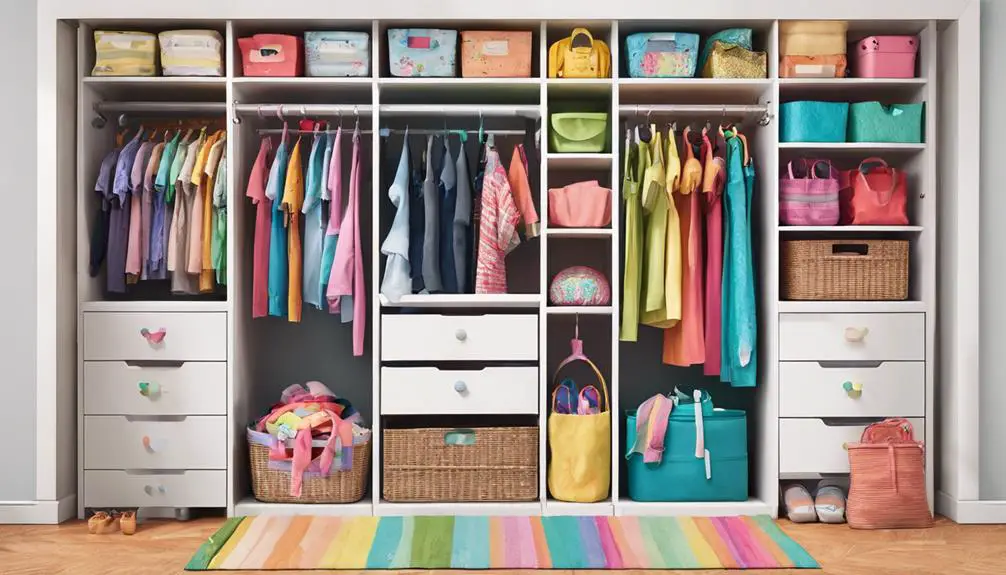
Maximizing your closet's vertical space is key to achieving ideal organization, and installing double rods is a simple yet effective way to do so.
By doubling up on rods, you're basically doubling your hanging space, which means you can store more clothes, accessories, or even bags in a smaller area.
When deciding on rod placement, consider the height of your child. If they're still growing, it's a good idea to install the rods at a lower height to make it easier for them to reach.
You can also adjust the rod placement according to the type of clothing you want to store. For example, you can place one rod higher up for longer items like dresses or coats, and the other rod lower down for shorter items like shirts or pants.
The double benefits of installing double rods are twofold.
Initially, it increases storage capacity, and subsequently, it encourages your child to keep their closet organized by making it easier to find what they need.
With more space to hang their clothes, they'll be less likely to throw them on the floor or leave them scattered around the room.
This simple solution can make a big difference in keeping their closet tidy and organized.
Installing Shelves for Folded Clothes
Control over clutter begins with a well-planned closet, and installing shelves for folded clothes is a crucial step in achieving this goal.
You'll want to design your shelves to accommodate your child's specific needs, taking into account the types of clothing they typically fold and store. Consider installing shelves with folded cubbies to keep items organized and easy to access. Each cubby can be labeled with a shelf label, indicating which items belong in each space.
When deciding on the number and size of shelves, think about your child's current clothing items and how they'll grow over time.
Adjustable shelves can be a great option, allowing you to customize the space as your child's needs change. Make sure the shelves are sturdy and securely attached to the wall to prevent accidents.
Utilizing Bins and Baskets Effectively
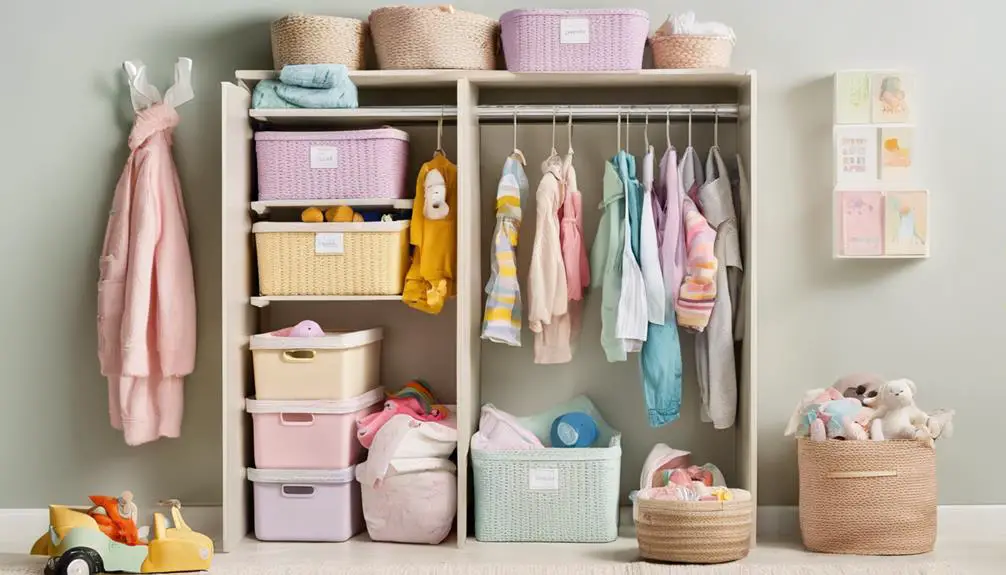
As you're assigning a home for each item in your child's closet, bins and baskets come into play, providing a tidy refuge for socks, underwear, and accessories.
When selecting bins, consider the size and type of items you need to store. Choose bins with labels or clear plastic to encourage your child to put things back in their place.
For smaller items like hair accessories or jewelry, opt for smaller bins or compartments to keep them organized and easy to find.
When it comes to basket arrangement, think vertically. Stackable baskets maximize storage space and keep the floor clear.
Place the most frequently used items in easy-to-reach baskets, and reserve higher or lower baskets for less frequently used items. Consider a basket with a divider to separate items like shirts and pants.
Creating a Designated Shoe Station
You're now going to tackle the often-daunting task of shoe storage by creating a designated shoe station.
This means exploring various shoe storage options, such as shelves, cubbies, or hanging organizers, to find the one that works best for your space and style.
Shoe Storage Options
Frequently, cluttered closets stem from a lack of designated spaces for specific items, and shoes are often the biggest culprits.
To tackle this issue, you'll need to create a designated shoe station with effective shoe storage options. You can start by installing shoe cubby ideas, such as individual compartments or shelves, to store each pair.
This will keep them organized, visible, and easy to access. For sneakers, consider sneaker racks that can be mounted on the wall or placed on the floor.
These racks come in various designs and can hold multiple pairs, keeping them upright and preventing them from getting scattered around the closet. You can also use stackable shoe racks or over-the-door shoe organizers to maximize storage space.
Remember to choose a shoe storage option that fits your child's needs and the closet's layout. By providing a dedicated space for shoes, you'll be able to maintain a clutter-free closet and teach your kids the importance of organization and responsibility.
Assigning Shoes a Home
Creating a designated shoe station is a crucial step in maintaining a clutter-free closet.
By assigning shoes a home, you're teaching your kids the importance of organization and making it easier for them to find their Sole mates (yes, we mean their favorite shoes!).
Start by designating a specific area of the closet for shoes.
You can install shoe cubbies or use stackable shoe racks to keep them organized. Label each cubby with the type of shoe or your child's name to make it easy for them to identify where their shoes go.
This will also encourage them to put their shoes back in their designated spot after use.
For an added touch, consider adding a shoe cleaning station with a soft brush, shoe polish, and a dustpan.
This will teach your kids the importance of taking care of their belongings and keeping their shoes looking their best.
Implementing a One In, One Out Policy
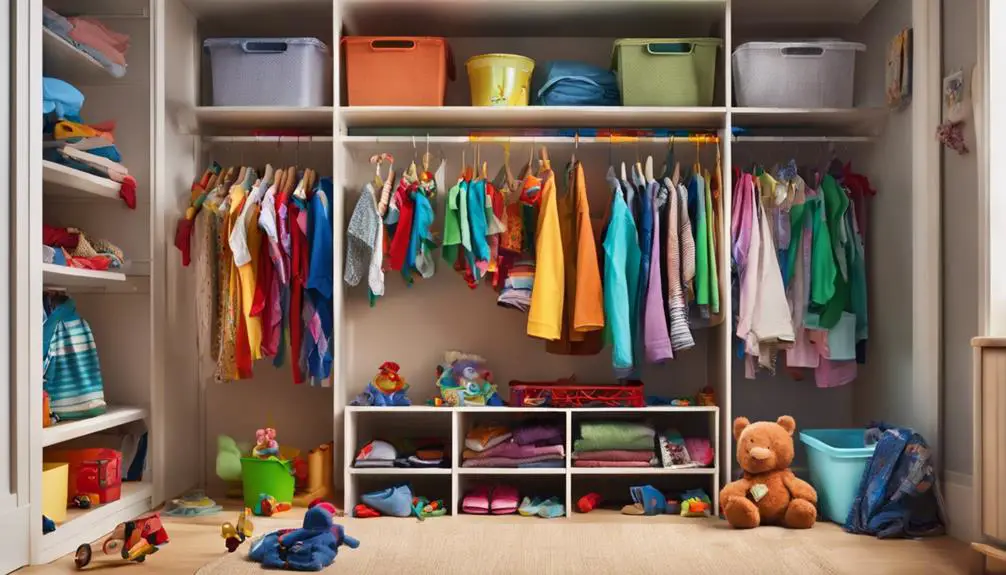
Your closet's limited space can be a constant reminder of the importance of editing your belongings.
Implementing a one in, one out policy helps maintain a balanced amount of possessions and prevents clutter buildup. This rule allows your kid to enjoy the freedom of choosing new items while giving you, as a parent, control over the amount of stuff that enters their closet.
When your kid wants to bring a new item into their closet, encourage them to let go of an old or outgrown one.
This practice helps them understand the value of each item and makes them more mindful of their consumption habits. You can also use this opportunity to teach your kid about decision-making and prioritization.
Teaching Kids to Hang Clothes Properly
As you help your kid maintain a balanced amount of possessions in their closet, it's equally important to teach them how to hang their clothes properly.
This essential skill will benefit them throughout their lives, keeping their closet organized and making mornings easier.
Teaching patience is key in this process.
Start by demonstrating how to hang clothes, explaining the importance of facing the clothes outward and grouping similar items together.
Then, let your kid try, offering guidance and encouragement as needed.
Consider using hang helpers like clips or dividers to make the process simpler and more manageable for them.
As your kid practices, emphasize the importance of taking their time and doing the task correctly.
Encourage them to hang clothes by type, such as dresses, tops, and pants, to create a visually pleasing and functional closet space.
Adding a Closet Organizer System
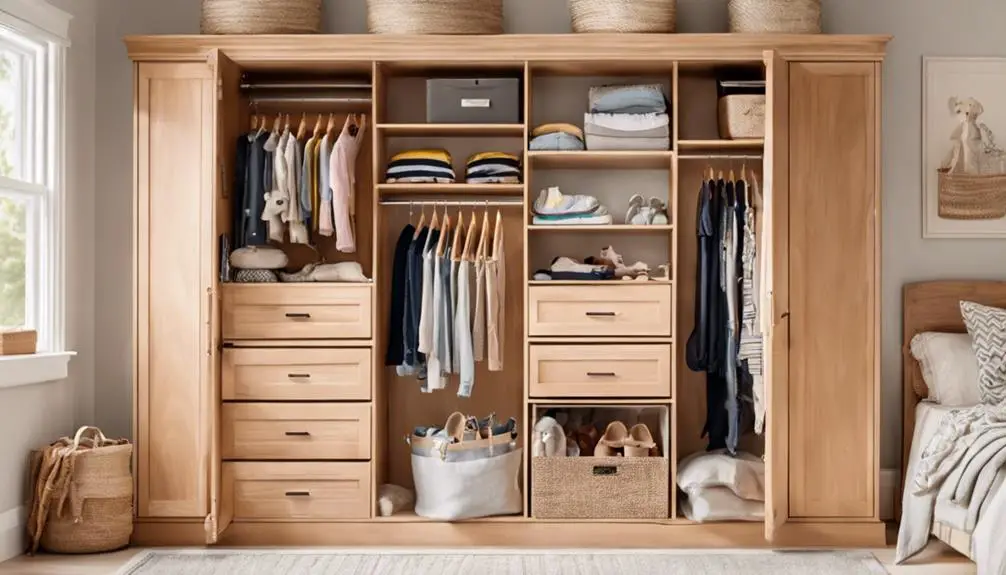
You can take your closet organization to the next level by adding a closet organizer system that's tailored to your needs.
Consider incorporating shelf dividers for kids to keep their belongings separate and organized. Adjustable storage bins and double rod options will also help maximize storage capacity and flexibility.
Shelf Dividers for Kids
Installing shelf dividers in your kids' closet is a great way to add a closet organizer system that promotes tidiness and makes the most of available space.
By separating items into distinct categories, you can help your kids develop good habits and maintain a sense of order.
When choosing shelf dividers, consider fun shelves with colorful dividers that can add a playful touch to the closet.
These dividers can be adjusted to fit different sizes of items, from small toys to larger clothing items.
You can also label each divider to help your kids quickly identify where things belong.
Shelf dividers are also an excellent way to teach your kids about categorization and prioritization.
By grouping similar items together, your kids can see what they've and make better decisions about what to wear or play with.
With shelf dividers, you can create a customized closet space that reflects your kids' personalities and meets their unique needs.
Adjustable Storage Bins
To further customize your kids' closet space, consider adding adjustable storage bins to your closet organizer system.
These bins are perfect for storing items like toys, clothes, and accessories, keeping them out of sight and organized. You can label each bin so your kids know exactly what's inside, making it easier for them to find what they need.
Adjustable storage bins are also great because they can be moved up or down the shelf as your kids grow and their storage needs change.
This flexibility guarantees that the bins remain functional and relevant, even as your kids' interests and preferences evolve. Plus, with flexible shelving, you can adjust the height and width of the bins to fit different items, making the most of the available space.
Double Rod Options
Maximizing closet space is a top priority when designing a closet organizer system for your kids.
One effective way to do this is by incorporating double rod options. By installing two rods, one above the other, you can substantially increase the storage capacity of the closet.
This is especially useful for kids who've a lot of clothes, as it allows them to hang up more items without overcrowding the closet.
When deciding on rod placement, consider the height of your child and the type of clothing they typically hang up.
For example, if your child is shorter, you may want to place the lower rod at a lower height to make it easier for them to access.
Additionally, if your child has a lot of dresses or longer items, you may want to place the rods farther apart to accommodate these items.
The double benefits of double rod options are twofold.
Not only do they increase storage capacity, but they also help to keep the closet organized by allowing your child to categorize and separate their clothes more easily.
This can help to reduce clutter and make it easier for your child to find what they need.
Incorporating a Shelf for Accessories
A few well-placed shelves can make a world of difference in your closet's organization, and dedicating one to accessories is a great way to keep them tidy and within reach.
This shelf will serve as a central hub for accessory storage, freeing up space in your closet and making it easier for your kids to find what they need.
When designing this shelf, consider the types of accessories your kids use most frequently.
If they love hats, scarves, and belts, install hooks or bins to keep them organized. For jewelry lovers, add a small tray or dish to corral earrings, necklaces, and bracelets. You can also add a small basket or container for hair accessories like clips, headbands, and ties.
Don't forget to add some shelf decor, like a fun wallpaper or colorful bins, to make the space visually appealing.
Designating a Spot for Backpacks
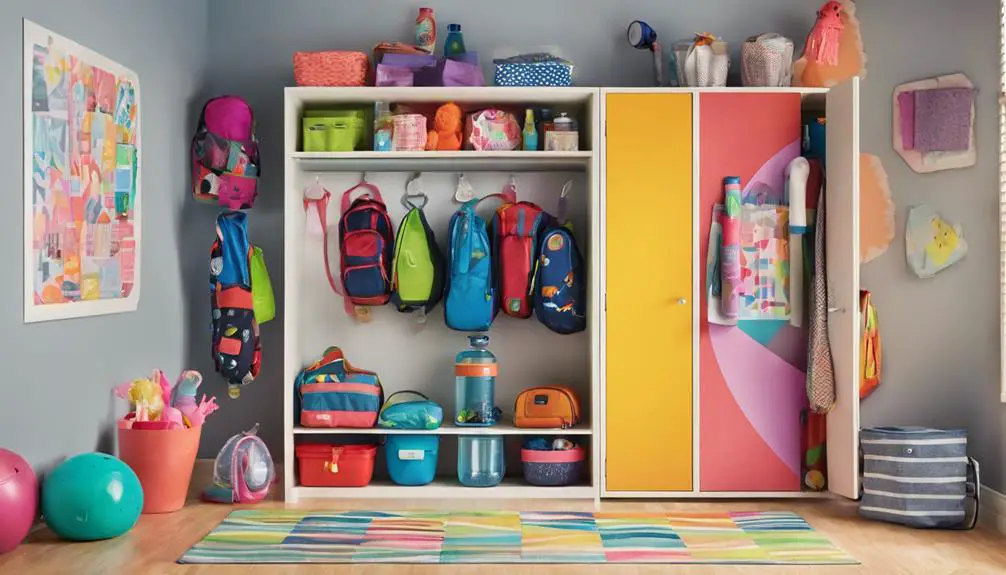
With backpacks being a daily essential for kids, it's crucial to designate a spot specifically for them in the closet.
This will help create a smooth morning routine, ensuring they grab their backpack and head out the door on time.
Consider installing backpack hooks or a backpack organizer on the back of the closet door or on a wall.
This will keep backpacks off the floor, preventing clutter from building up and making it easier for your kids to hang up their backpacks every day.
You can also use this spot to store lunchboxes, water bottles, or other school supplies, keeping everything they need in one convenient spot.
Maintaining the Newly Organized Space
Now that you've designated a spot for backpacks, it's time to think about how to maintain this newly organized space.
You've worked hard to get everything sorted out, and you want to keep it that way. One key to maintaining your kid's closet organization is to establish daily reminders.
This can be as simple as creating a routine where your child puts away their backpack and hangs up their coat every day after school. You can also set reminders on your phone or put a note on the fridge to help them remember.
The goal is to create a habit of putting things back in their designated spot, making it second nature for your child. Habit formation takes time and practice, so be patient and consistent.
Encourage your child to take ownership of their space and praise them when they do a good job of keeping it organized. By making maintenance a part of their daily routine, you'll be teaching them valuable skills that will benefit them throughout their lives.
Frequently Asked Questions
How Often Should I Help My Kid Maintain Their Closet Organization?
You should help your kid maintain their organization daily by encouraging them to put away toys and clothes, and weekly by doing a deeper tidy together, establishing routines that foster responsibility and independence.
Can I Use Closet Organizers Designed for Adults in Kids' Closets?
You can use adult closet organizers in kids' closets, but consider kid-friendly designs and age-specific styles that cater to their unique needs, ensuring a functional and fun space that grows with them.
What Is the Ideal Age to Start Teaching Kids Closet Organization?
You'll want to start teaching kids about closet organization around age 5, when they develop a sense of ownership and basic motor skills, and adapt your approach based on their individual child development and your parenting style.
How Do I Handle Sentimental Items That My Kid Refuses to Part With?
When dealing with sentimental items, you create a Memory Box with your kid, acknowledging their Emotional Attachment. Together, decide what to store and what to let go of, teaching them to cherish memories without clutter.
Can a Closet Organizer System Be Installed in a Rental Property?
You'll need to check your rental agreement for any restrictions on making changes to the property before installing a closet organizer system, and don't forget to get your landlord's approval to avoid any potential issues.
Conclusion
You've got this! You've sorted, purged, and assigned a home for each item. Now, it's time to maintain your newly organized space. Set aside some time each week to keep your closet tidy. Hang up clothes that are wrinkled or out of place, and put away items that are not being used. By keeping your closet organized, you'll save time getting ready in the morning, reduce stress, and develop good habits that will last a lifetime.
